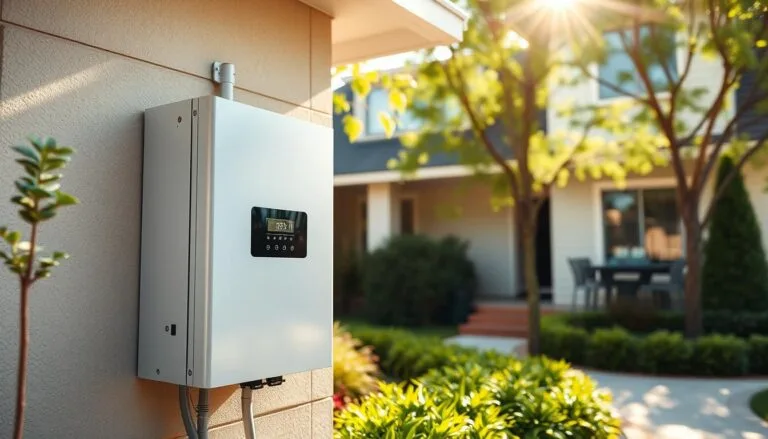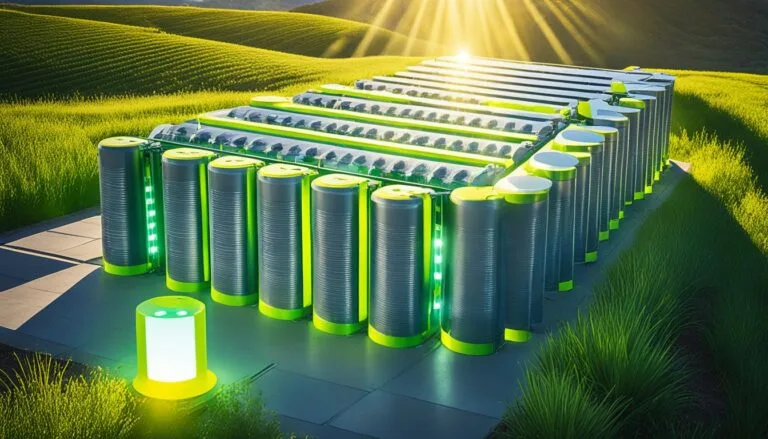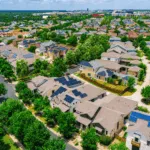Homeowners often wonder if they should oversize their solar systems. The goal is usually to save money and be energy independent. But, oversizing might not always be the best choice. It depends on several factors like your energy needs now and in the future, local rules, and the cost of the system.
Net metering can give you credits for extra energy you produce. But, these credits might not pay you cash. They could just reduce your bill or expire, based on your utility’s rules. An oversized system might also mean a longer wait to see any savings, which could be a problem if you don’t have a good use for the extra power. Should I Get More Solar Panels Than I Need?
Key Takeaways
- Maximum savings may not align with oversizing solar panel systems due to utility export limitations and non-monetary crediting practices.
- Utility policies on excess solar production and net metering can significantly influence the financial benefits of solar installation.
- Oversized solar systems demand a higher upfront cost, which prolongs the period to recoup the investment.
- Understanding and determining solar panel requirements can aid in optimizing system size for both current and future energy consumption scenarios.
- Homeowners contemplating future home improvements or electric vehicle purchases may find oversized systems advantageous.
- The “120% Rule” of the National Electric Code is a critical benchmark for US residential solar installations, preventing excessive oversizing according to utility guidelines.
- The potential for increased SREC income and tax credit availability may provide financial incentives to consider a larger system.
Understanding the Basics of Solar Panel Sizing
Solar panel sizing is key to getting the most out of solar energy systems. For both homeowners and businesses, knowing how to find the right number of panels can save a lot of energy and money. It’s all about doing the math right to make your solar setup work best.
What Determines Your Solar Panel Requirements?
Your solar needs depend on a few things like how much electricity you use, how sunny your area is, and the panels’ efficiency. The power each panel can produce, your roof’s shape, and your energy goals also matter. For example, how well a system works in real life versus perfect conditions can change how many panels you need.
Matching Solar Panel Quantity with Usage Patterns
Getting the right number of solar panels means matching your daily energy use with what your solar system can make. The size and how well panels work affect this match. For example, SunPower® Maxeon® cells are more efficient, so you might need fewer panels to meet your energy needs. Knowing the differences between solar panel types helps you make the best choice for your money.
Consider this: A typical U.S. home uses about 900 kWh per month. But a big house in a sunny area might use up to 2,000 kWh. So, you might choose between 25 standard panels or about 17 SunPower panels.
Let’s look at how many panels you might need for different homes and climates:
| Home Type | Monthly Energy Usage (kWh) | Required Number of 250W Panels | Required Number of 370W SunPower Panels |
|---|---|---|---|
| Small Home (Temperate Climate) | 200 | 10 | 7 |
| Average Home (U.S. Standard) | 900 | 25 | 17 |
| Large Home (Warm Climate) | 2000 | 55 | 37 |
Choosing the right number of solar panels isn’t just about covering your roof. It’s about finding the perfect balance between how many panels you have and how much energy you use. This ensures your system works well without wasting energy or causing problems with the power grid.
Considering Net Metering and Utility Policies
When looking into solar panel installation considerations, it’s key to grasp the details of net metering and its impact on your solar project. Net metering lets homeowners send extra electricity back to the grid for credits. But, the value of these credits varies by state rules and utility policies.
In places like New Jersey and Florida, net metering is very beneficial, giving credits at the full retail rate. This can save a lot of money, especially with excess solar panel capacity to produce more energy. For instance, in New Jersey, solar panels pay off in about four to five years with net metering, much faster than without it.
But, it’s vital to watch for changes in net metering policies. For example, North Carolina is making updates that could affect solar users’ savings, as seen in a recent EnergySage article.
| State/Policy | Credit System | Average Payback Period |
|---|---|---|
| New Jersey (Net Metering) | Full Retail Rate | 4-5 years |
| California (Net Billing 3.0) | 25% Retail Value | Reduced by 75% |
| Florida (Net Metering) | Full Retail Rate | Competitive |
To benefit from net metering, homeowners should act fast as policies might change and reduce savings. Adding solar batteries can also boost your savings. In areas with good net metering rates, using batteries with excess solar panel capacity can save even more during high rates.
As utility companies and laws get more complex, knowing and understanding these policies is crucial. It helps you get the most from your solar energy investment.
Should I Get More Solar Panels Than I Need?
Thinking about adding solar panels to your home or business raises questions about how many you should get. Should you aim to just meet your energy needs or go beyond? This part looks at the good and bad of choosing more solar panels. It focuses on solar panel efficiency and the effects of overestimating solar panel needs.
Benefits of Excess Solar Panel Capacity
Having extra solar panels can be a smart move, especially if you’re looking at Solar Renewable Energy Credits (SRECs). These credits can lead to big savings on your energy bills. Plus, solar panels can increase your home’s value by about 6.8%, as studies show. If your area gets a lot of sun, you might find that extra panels pay off by making more electricity on sunny days.
Drawbacks of Overestimating Solar Panel Needs
But, getting too many solar panels has its downsides. The cost to install them can be high, around $19,000. And, the savings might not match your budget if you’re not planning to stay in your home long. Also, adding too many panels can be hard to set up, taking more time and money. This highlights the need for careful planning and accurate calculations before installing solar panels.
| Consideration | Benefit | Drawback |
|---|---|---|
| Financial return from incentives | Can be substantial with high energy production | Upfront costs may outweigh returns if not planned properly |
| Home value | Increases average home value significantly | Does not benefit if moving in the short term |
| Energy production | Maximizes output on sunny days | Excess may not be utilized effectively, leading to waste |
In conclusion, while extra solar panels have their perks, think carefully about the costs and your future plans. Make sure your solar investment matches your goals for both your wallet and the planet.
Assessing the Financial Implications of Larger Solar Investments
Looking into the financial implications of bigger solar setups, it’s key to weigh the pros and cons. Getting the right number of optimal solar panels meets your energy use and boosts your home’s value.
At first, bigger solar systems might seem pricey, costing between $10,000 to $18,000 in the US. But, they could raise your property’s value by about 4%, or $9,000 on average. Plus, they cover 96% of your home’s power needs, cutting down your energy bills.
| Aspect | Impact |
|---|---|
| Upfront Cost | $10,000 to $18,000 |
| Average Property Value Increase | 4% / $9,000 |
| Electricity Coverage | 96% |
| Potential Return on Investment | 241.31% over 25 years |
The ROI for solar setups is strong, at 241.31% over 25 years. This is boosted by a 30% federal tax credit and state incentives, making solar more budget-friendly. Learn more about these incentives.
When looking at the financial implications, the optimal solar panel quantity should match your energy use. You can also sell extra energy back to the grid with net metering policies. For tips on improving your system’s efficiency, check out advice from solar inverter experts.
In conclusion, the upfront cost might be steep, but the long-term gains of more solar panels are worth it. These benefits include higher property values, lower energy bills, and a good return on investment from increased energy production.
The Impact of Oversizing on Solar Panel Efficiency
Oversizing solar panel systems is a common choice for homeowners and businesses. They aim to boost solar panel efficiency and prepare for future energy needs. This method has both upsides, like more energy production, and downsides, like energy clipping.
Maximizing Energy Production with Oversizing
Installing more panels than needed helps capture more sunlight, especially during peak hours. This is great for places like California and Georgia, where energy costs will likely go up. Oversizing means the system stays effective even as panels lose some power over time.
Understanding the Phenomenon of Energy Clipping
Oversizing boosts energy generation but can lead to energy clipping. This happens when solar panels produce more power than the inverter can handle. It often occurs when the sun shines the brightest.
Still, the benefits of making more energy outweigh the issues. For example, using a SolarEdge HDWave 7.6kW inverter with a certain solar array can manage overproduction well. This reduces waste and keeps the system running efficiently.
Choosing the right panel-to-inverter ratios is key. Pairing a 290W Enphase IQ7+ micro-inverter with a 320W-350W panel keeps efficiency high and clipping low.
Below is a comparison of oversizing’s financial and performance effects:
| System Size | Expected Lifetime Efficiency Loss | Inverter Capacity (W) | Cost Increase per Additional Panel |
|---|---|---|---|
| Standard | 10-20% | 7,600 | $0 |
| Oversized by 3 Panels | 8-18% | 7,600 | $3,750 |
The table shows that oversizing costs more upfront but can save money over time. With rising energy prices and falling solar equipment costs, this could be a smart move.
Interconnection Challenges with Oversized Solar Systems
Installing oversized solar systems comes with big hurdles. Many think figuring out determining solar panel requirements is easy, just looking at past energy use. But, utility companies often use this past use to decide on solar system connections. This can be a big issue for systems meant to use more power than before.
A big issue is that 41 percent of community solar projects stopped applying to connect to the grid. This was mainly due to the rules and size limits set by companies like the Public Service Company of Colorado. This problem is seen in many states, showing a big struggle nationwide.
Now, regulators in over a dozen states are trying to make connecting easier. This is key because big systems get a lot of checks, which can stop the project or make it too expensive. In Massachusetts, for example, waiting to connect can take up to three years, and the costs for connecting can be a big part of the total cost.
Companies like Xcel Energy have connected a lot of solar power to their networks. This shows that even with challenges, it’s possible to overcome them. With smart plans and better solar inverter choices, connecting bigger solar systems can be easier.
To deal with these interconnection challenges, people thinking about solar should talk to experienced installers. They should also look at current rules and think about possible future changes. Getting the right solar panels means meeting your energy needs and following the rules. It also makes connecting smoother.
Exploring Solar Energy Calculations for Optimal System Size
Getting the right size for your solar system is key to saving money and using energy well. First, think about how big your house is and how much you use energy. This helps figure out what you need for solar panels.
Calculating Your Specific Energy Needs
Start by looking at how much energy your house uses each month. A 1,500 sq ft house might use 630 kWh, while a 2,500 sq ft house could use 840 kWh. This info helps you know how many solar panels you need.
Installing solar panels costs about $16,000 on average. You might need 17 to 30 panels to cover your energy use. In places like Massachusetts, a typical system is 10.01 kW and costs around $23,054 after incentives.
Forecasting Future Energy Requirements
Think about your future needs, like getting electric cars or using more energy appliances. Adding solar battery storage might be a good idea for more energy use. Remember, a bigger house or more people means you’ll use more energy.
As your house and energy needs change, your solar setup should too. Planning for the future helps make sure your solar system is the right size. This way, you save money and help the environment.
Electric Vehicles and Solar: Planning for Future Consumption
Electric vehicles (EV) sales in the US jumped by 11.3% in the second quarter of 2024. This shows a big increase in demand for green transportation. Homeowners now need to think about how an EV will change their energy use. Since EV owners often choose renewable energy, planning for solar energy is key.
The Tesla Model Y, the top-selling EV in America, uses about 3.57 miles per kWh. This means it needs around 394 kWh a month, according to Edmunds. This info is important for planning the solar setup needed for EV charging.
Now, solar installations are growing fast, with 75% of new power coming from solar in the first quarter of 2024. This is a big jump from 2020. To charge an EV, you might need 7 to 12 solar panels, depending on the car’s battery size. Planning for solar needs now can avoid costly updates later.
Using solar energy with EVs helps the environment too. It cuts fuel costs and reduces carbon emissions. As solar tech improves, EVs might even charge themselves with built-in solar panels. This partnership between solar and EVs is changing the future of transportation and energy use.

























